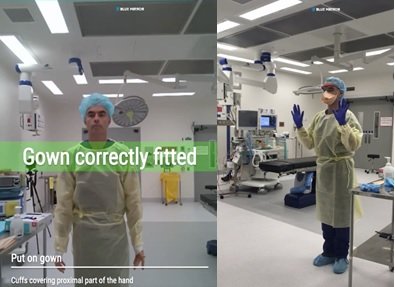In July 2019, NHS England and NHS Improvement launched the NHS Patient Safety Strategy for safer culture, systems, and patients. A part of this strategy was the development of the Patient Safety Incident Response Framework (PSIRF), published in August 2022, with implementation scheduled for the end of 2023. This piece is a comprehensive guide to PSIRF — what it means, who it applies to, what organisations must do, and more.
What is PSIRF?
The Patient Safety Incident Response Framework (PSIRF) sets out the NHS's approach to developing and maintaining effective systems and processes for responding to patient safety incidents to learn and improve patient safety. PSIRF replaces the Serious Incident Framework (SIF) established in 2015.
The PSIRF supports the development and maintenance of an effective patient safety incident response system that integrates four key aims:
Why is PSIRF replacing the Serious Incident Framework?
Shortly after the Serious Incident Framework (SIF) was published, NHS England began receiving feedback from patients, families, and staff regarding their experiences with patient safety incident investigations. They felt that the process was closed and defensive rather than one that supported learning and improvement, as it was intended to do.
Despite providing resources on how to conduct investigations within organisations, there was no visible return on investment in terms of sustainable change and improvement, indicating challenges around the entire process.
In response, NHS England initiated public engagement activities to identify and address the root causes of these problems. The key issues identified were a lack of time and skills among NHS investigators, who often juggled these patient safety incident investigations alongside their regular responsibilities. Investigations were seen as a performance management tool with targets and strict deadlines, overshadowing the goal of positively impacting those affected by serious incidents.
NHS England and NHS Improvement used this information to determine how they could change processes and support their goal of effectively responding to patient safety incidents. This led them to PSIRF.
How is the PSIRF different from the SIF?
The PSIRF fundamentally shifts how the NHS responds to patient safety incidents for learning and improvement.
A key distinction between the Serious Incident Framework (SIF) and the PSIRF is that the latter does not differentiate between "patient safety incidents" and "serious incidents". By eliminating the "serious incidents" classification and its associated threshold, the PSIRF represents a significant change in how the NHS responds to patient safety incidents as a whole, and is a major step towards implementing comprehensive safety management systems across all organisations.
Another differentiator is that PSIRF is not an investigation framework that prescribes what to investigate. Instead, it advocates a co-ordinated and data-driven approach to patient safety incident response, focusing on compassionate engagement with those affected.
Under PSIRF, organisations are required to develop a thorough understanding of their patient safety incident profile, ongoing safety actions, and established improvement programmes.
Through the patient safety incident response planning exercise that involves providers and key stakeholders, the organisation can identify its capacity to respond to incidents, considering factors such as the availability of trained investigators, their time constraints, and the variety of response methods at their disposal. They can then determine an appropriate and proportionate response in the event of an incident.
In a nutshell, the PSIRF focuses on:
Improving the experience of those affected by an incident, be it the organisation's staff, patients, or their families.
Transitioning towards a considerate approach where organisations assess patient safety incidents to identify the most significant learning opportunities, understand ongoing improvement efforts, and only then determine an appropriate response.
Leveraging a broader, more effective range of methods to support insight gathering and learning rather than methods that assume simplistic, linear identification of a single cause.
Establishing effective governance structures and oversight processes to respond to patient safety incidents, through the collaborative efforts of all healthcare organisations that deliver and oversee NHS-funded care.
Who does the PSIRF apply to?
The PSIRF is a contractual requirement under the NHS Standard Contract and is mandatory for services provided under that contract, including acute, ambulance, mental health, community healthcare provider, maternity, and all specialised services.
Further, organisations that provide NHS-funded secondary care under the NHS Standard Contract but are not NHS trusts or foundation trusts are required to adopt the PSIRF for all aspects of NHS-funded care.
Primary care providers may also wish to adopt PSIRF, but it is not a mandatory requirement at this stage. Those wanting to use PSIRF within their organisation must work with their integrated care board (ICB).
What must organisations do?
Organisations are required to apply the PSIRF in the development and maintenance of the following:
1) Patient Safety Incident Response Policy: This defines the organisation's approach to responding to and learning from patient safety incidents for improvement. It includes information about the current systems, processes, and governance processes, engagement strategies for those affected by a patient safety incident, and how learning responses will be translated into improvement work across the organisation. You can access the national policy template here.
2) Patient Safety Incident Response Plan: Based on the organisation's patient safety incident profile, ongoing improvement priorities, available resources, and the priorities of all stakeholders, this document should specify the methods the organisation intends to use to maximise learning and improvement and how these will be applied to different patient safety incidents. You can access the national plan template here.
Both documents must align with the organisation's wider approach to safety improvement and should be published on the organisation’s website.
How can organisations use the PSIRF?
As mentioned in the previous section, organisations must apply the PSIRF in developing and maintaining the Patient Safety Incident Response Policy and Plan. To help them with this, NHS England has put together the following documents:
A comprehensive preparation guide to implement the framework and templates for the local patient safety incident response policy and plan
Guidance on engaging and involving patients, families, and staff following a patient safety incident
Response planning and tools, guides, and report templates
Patient Safety Incident Response Standards, including training requirements
The roles and responsibilities of those overseeing incident response
You can find these resources here.
What is the PSIRF Learning Response Toolkit?
When working with early adopters, the team at NHS England found that there needed to be a shared understanding of a patient safety incident investigation. So, to create more awareness, they put together the PSIRF toolkit that contains a range of system-based approaches and national tools that incorporate the SEIPS (Systems Engineering Initiative for Patient Safety).
Organisations are encouraged to use the toolkit to explore the contributory factors to a patient safety incident or cluster of incidents and to inform improvement. Broadly, the PSIRF toolkit contains:
Preparation Tools: Typically done in the early stage of the learning response, this includes an information gathering log, stakeholder maps, and a template to help define the Terms of Reference (ToR) for an investigation.
Learning response methods: This includes the After Action Review, Multidisciplinary Review, Swarm Huddle, and the patient safety incident investigation overview.
Everyday work guides: Designed to support the exploration of how care is delivered day-to-day in the real world, this includes staff guidance on conducting empathetic, supportive interviews during learning responses, link analysis, and walkthrough analysis.
Additional tools: Some other tools available in the PSIRF toolkit are a thematic review tool, horizon scanning tool, timeline mapping, work system scan, SHARE debrief tool, and a safety action development guide to help providers identify areas of risk, actions to reduce them, and how to take the learning and translate it into meaningful action.
You can find these resources here.
What do early adopters of the PSIRF have to say?
NHS England interviewed some of the early adopters of the PSIRF within their organisation to understand their experience with the new framework and their advice to providers who are now implementing PSIRF. Here's what some of them had to say:
Lucy Winstanley, Head of Patient Safety and Quality, West Suffolk NHS Foundation Trust
According to Lucy, West Suffolk NHS Foundation Trust identified an opportunity for change with the PSIRF while recognising the limitations of the Serious Incident Framework. She attributes the successful implementation of PSIRF to the organisation's board, which demonstrated an early commitment, embraced change, and remained open to collective learning.
That said, the organisation faced the challenge of spending considerable time on quantitative investigations that weren't high quality. To overcome this, they recruited specialised patient safety incident investigators who brought a wealth of experience and a different approach, significantly improving staff and patient engagement in the process. This strategic move ensured better support, enhancing the overall effectiveness of the system.
Lucy's advice to those transitioning to the PSIRF:
"You have to approach it as a collective with the freedom to know that you are making a change and doing it for the right reason. Flexibility and appetite for change have to be the drivers here because it is very different from what you know already — there will be questions and grey areas. Still, as a collective, if you're confident of your approach and keep patients at the heart of it all, it will be successful."
Megan Pontin, Patient Safety Incident Investigator, West Suffolk NHS Foundation Trust
Megan believes the PSIRF significantly differs from the Serious Incident Framework in many ways. Specifically, she finds involving patients, families, and staff right at the beginning of an investigation a game-changer.
Here's what Megan wants providers to bear in mind during the transition:
"Remember that this is quite a long journey, and you can't set it all out at the start. We all focus on doing the investigations correctly and learning from them. But the part about then transferring that into an improvement activity is perhaps the part that none of us had a strong framework on before. The PSIRF now allows us to do that, and that's where we need to focus."
Saranna Burges, Director for Patent Safety and Quality, Norfolk and Suffolk NHS Foundation Trust
According to Saranna, the PSIRF has empowered clinical staff to participate actively in every phase of the incident investigation process — from the early screening or the review of the incident to the debriefing and decision-making. This involvement has fostered a sense of ownership and engagement among them, offering valuable insights into the range of incidents within the trust and their effects on patients and caregivers.
Saranna's advice for mental trusts who are now implementing the PSIRF is:
"Get it right from the start what you're looking to do. You're looking to target areas where you have the most care and treatment concerns, not areas where you have the most incidents. Although that has to feature in your decision-making, it's the areas of care and treatment you must focus on. Be prepared for the fact that it won't reduce the activity levels. You're just going to be doing something different."
Lisa Falconer, Head of Clinical Quality and Patient Safety, NHS Derby and Derbyshire ICB
Lisa believes that the adoption of the PSIRF has resulted in trusts becoming more targeted in their approach to improvement plans. They now aim to embed and sustain these plans within their organisation, as opposed to merely identifying actions and documenting them in an investigation report, never to be revisited.
Lisa's advice to ICB leads is:
"The key is to get providers together and work alongside them every step of the way, guiding and supporting them by ensuring their plans are fit for purpose. Make sure to do every part of the journey; make sure you do all of it to get the most out of the PSIRF."
How can MEG help?
MEG is an intuitive, cloud-based digital quality management system that supports engagement in care quality, safety, and compliance initiatives through incident and complaint activity tracking, effective policy and document management, and real-time reporting and analytics.
As an LFPSE-compliant and PSIRF-compatible vendor, MEG provides customisable workflows and tools for quality assurance and incident management.
















